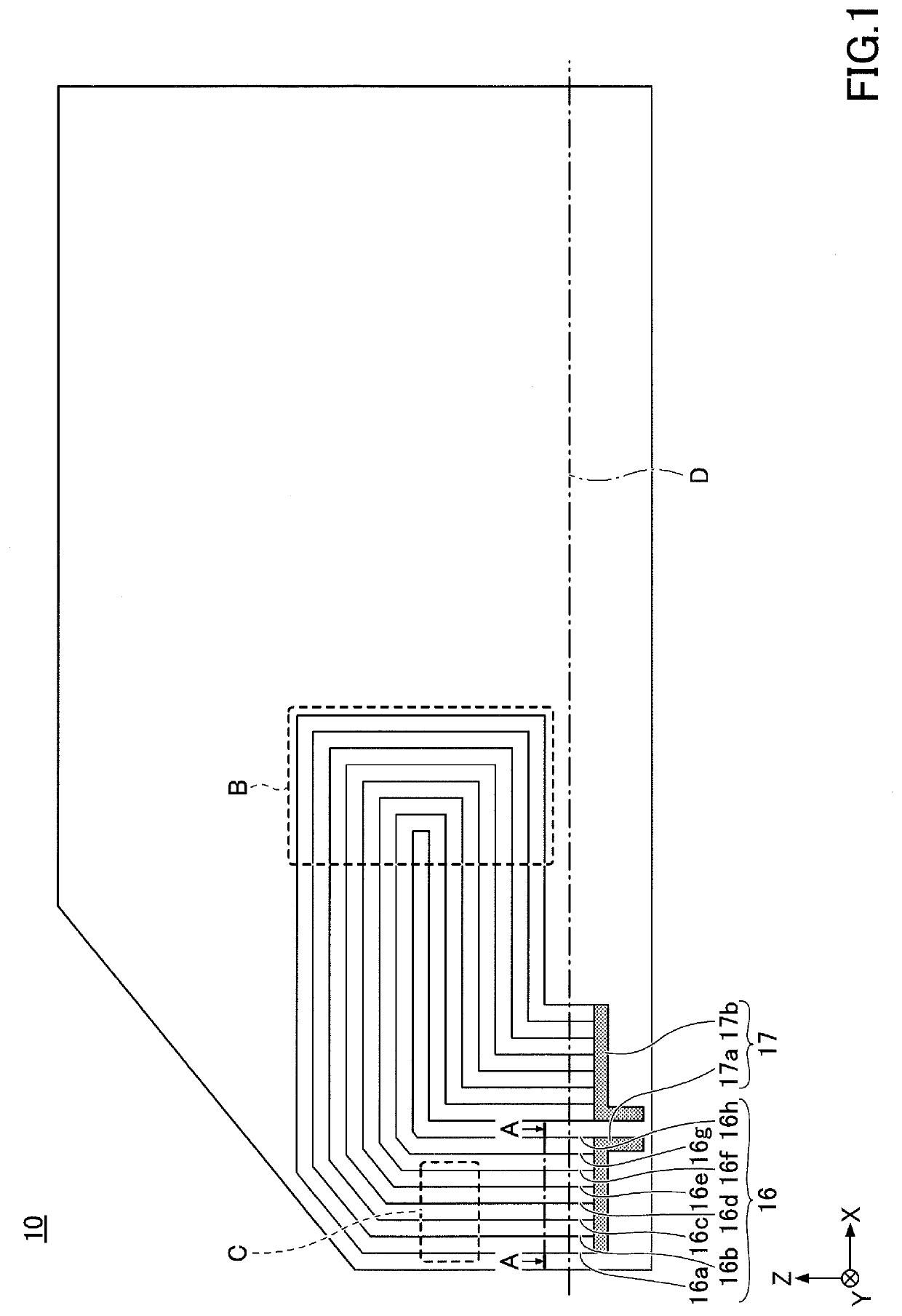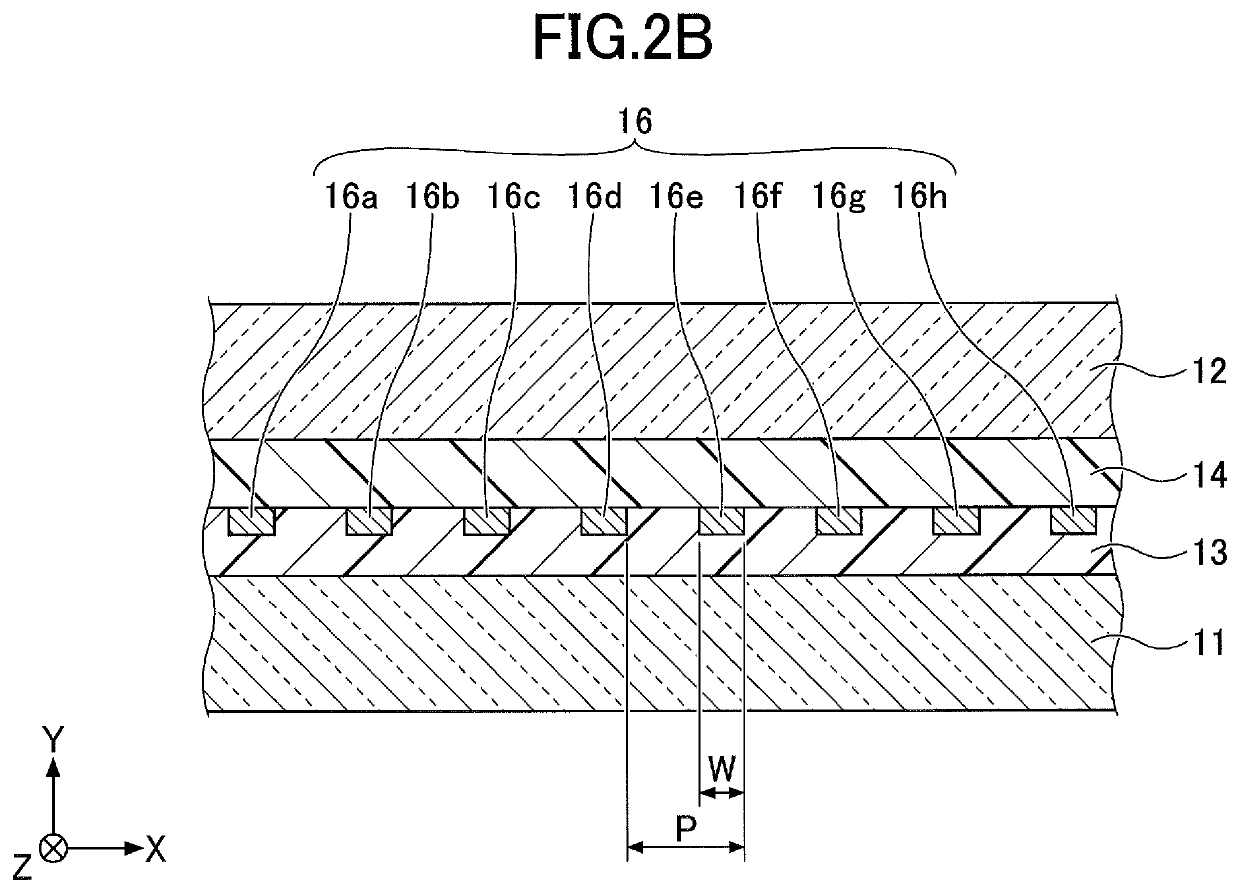Laminated glass
- Summary
- Abstract
- Description
- Claims
- Application Information
AI Technical Summary
Benefits of technology
Problems solved by technology
Method used
Image
Examples
first embodiment
[0026]FIG. 1 is a drawing illustrating a side glass for a vehicle according to the first embodiment. FIG. 2A is a partially enlarged cross-sectional view taken along line A-A of FIG. 1. In FIG. 1, a left-hand side (the base of arrow X) corresponds to the front, and a right-hand side (the tip of arrow X) corresponds to the rear, when side glass 10 is attached to the vehicle. In FIG. 1, the lower side (the base of arrow Z) corresponds to the floor side, and the upper side (the tip of the arrow Z) corresponds to the roof side, when the side glass 10 is attached to the vehicle. In FIG. 1, an area below an alternate long and short dash line D is an area that is hidden behind the vehicle body and cannot be seen from the outside of the vehicle when the side glass 10 is attached to the vehicle.
[0027]As illustrated in FIG. 1 and FIG. 2A, the side glass 10 includes, as main constituent elements, a pair of glass plates 11 and 12, a pair of intermediate adhesive layers 13 and 14, and a base mat...
second embodiment
Modification of Second Embodiment
[0076]The modification of the second embodiment shows an example in which detailed specifications are changed in the second embodiment. In the modification of the second embodiment, the explanations about the same constituent elements as those already described may be omitted.
[0077]FIG. 5 is a drawing illustrating a side glass for a vehicle according to the modification of the second embodiment. The side glass 10B illustrated in FIG. 5 is generally similar to the side glass 10A (see FIG. 4), but the details are different.
[0078]FIG. 6 is an enlarged view illustrating a portion E of FIG. 5. As illustrated in FIG. 6, in the side glass 10B, a pitch P1 between nearest line segments of an innermost conductive thin wire at the turnaround is equal to a pitch P2 of conductive thin wires around the innermost conductive thin wire. In other words, the pitch P1 of the conductive thin wire 16h turned back in the smallest loop is equal to the pitch P2 of conductive...
third embodiment
[0086]The third embodiment is an example for providing a plurality of sets of bus bars. In the third embodiment, the explanations about the same constituent elements as those already described may be omitted.
[0087]FIG. 9 is a drawing illustrating a side glass for a vehicle according to the third embodiment. The side glass 10C illustrated in FIG. 9 is different from the side glass 10A (see FIG. 4) in that the side glass 10C includes two zones (zone Z1 and zone Z2) arranged in parallel in the X direction and configured to be able to heat substantially the entirety of the side glass 10C. In the side glass 10C, the specification of the zone Z1 is the same as that of the side glass 10A, and the explanation thereabout is omitted.
[0088]In the side glass 10C, the zone Z2 is provided with one set of bus bars 27 independent of the bus bars 17 in the zone Z1. In the present embodiment, there are two aggregations of conductive thin wires in which currents flow in the same direction, and there a...
PUM
| Property | Measurement | Unit |
|---|---|---|
| Fraction | aaaaa | aaaaa |
| Length | aaaaa | aaaaa |
| Length | aaaaa | aaaaa |
Abstract
Description
Claims
Application Information
 Login to view more
Login to view more - R&D Engineer
- R&D Manager
- IP Professional
- Industry Leading Data Capabilities
- Powerful AI technology
- Patent DNA Extraction
Browse by: Latest US Patents, China's latest patents, Technical Efficacy Thesaurus, Application Domain, Technology Topic.
© 2024 PatSnap. All rights reserved.Legal|Privacy policy|Modern Slavery Act Transparency Statement|Sitemap



